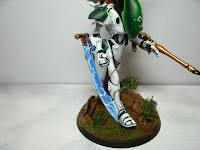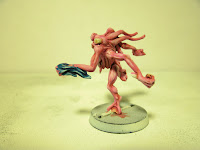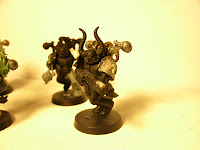A phrase commonly heard around the game store is "table quality" or "game quality," referring to an army's paint job. Whichever way you say it, the meaning is the same, 'this is an army that performs best on the tabletop, not sitting on a shelf.' And that's ok. Not every model you paint has to be aimed at achieving golden demonhood. The 9 months it takes to paint a Slayer Sword winner simply isn't a reasonable approach for each model in your army. However, by utilizing a few key techniques, a clean, crisp and table ready army can be painted in no-time.
I've been playing Biel-tan Eldar for eight years now, having collected somewhere near 4,000pts worth of minis. This article is going to focus on that collection, and the basecoating, highlighting, and modelling techniques that will turn heads and garner praise wherever you take your army.
Let's take a look at some Dire Avengers and what makes them pop on the battlefield.
There are some gamers who hate the assembly phase of putting together minis. "It's boring and monotonous!" they say. They're looking at it the wrong way, assembly is your first chance to personalize your miniatures and make them unique. For instance, these two Dire Avengers, for all intents and purposes regular squad members. However, the simple cutting of the ammo clip from the shuriken catapult and posing of the arm to be reaching for a new clip or ready to slam one home adds a level of unique detail to the minis that gives them a realistic battlefield feel.
When constructing new models ask yourself three questions:
1. "What would this model be doing as they prepare/get to battle?"
2. "What would this model be doing before reaching hand-to-hand combat?"
3. "What would this model be doing in combat?"
I answered question number 2 by saying the Dire Avengers would be shooting the crud out of something and reloading as they did so. Remember, nothing was altered besides the clip being removed from the gun, that maximum conversion for minimal effort!
Next, let's take a look at the squad exarch and a few features that helps him stand out on the table top.
His paint scheme is relatively simple: prime black, base coat 'regal blue,' broad highlight 'enchanted blue,' and final highlight 'ice blue.' His green features are primed the same, but base coated with 'dark angels green,' broad highlighted with 'snot green,' and final highlighted with 'scorpion green.' How to go about applying the colors is to paint on 1-2 thin layers of the base coat, until you get a nice uniform coat with no darker areas (one coat might be too thin and show through to the primer, appearing darker than the rest of the coat). Next, a broad highlight of a lighter shade is applied by using a standard brush around armor plate edges. Apply liberally, covering approximately 1/2 to 2/3 of the desired area. It also helps to layer an extra coat nearer to the armor plate edge where your final highlight will be to give the effect of gradation and shading between highlights (this isn't actually shading, but a quick trick to look like you did). Finally, add the top-most highlight with a fine detail brush (standard will do with a light hand) and paint on a nice clean line, following the contour of the plate edge. If you smudge or mess up, don't worry, just trim the smudge off by applying the lower level coat (i.e. to trim 'ice blue' use 'enchanted blue' to paint off the offending misstep). This is also a great technique to use simply to gain sharp lines, paint the final highlight and then use the color underneath it to repaint the highlight edge getting the sharpness to the line you want.
It's safe to say that over eight years my painting technique has increased and that my early models look a bit shabby next to my latest creations. This is a common occurance amongst gamers and should be viewed like touching up paint chipping and battle damage.
This is the first wraith lord, painted about four years back. The base painting was good, but it lacked levels of highlighting that I didn't start utilizing until later in my hobby career. A quick addition of a broad 'snot green' highlight and final 'scorpion green' highlight (pictured above) quickly gave the model the added pop it needed to stand out on the table top. When viewed from a gaming perspective, highlights on top of a clean base coat go a long way.
A few years later and I was ramping up the painting technique on my second wraith lord. This time I applied the fundamentals of wet-blending on green surfaces to achieve a broader highlight and increase the overall depth of a surface, instead of just picking out the edge detail. How I did this was to apply my broad 'snot green' highlight to the center on the highlight focus (in this case the center of the wraith lord's head). To do this I would dip my brush in water, remove most the excess, and then get some paint out of my pot. The paint is slightly watered down at this point and applies in super thin coats (you can also use a wet palette for this technique, see last month's post for more details). Starting with my brush at the very edge where I would like the broad highlight to stop, I dragged the brush to the highlight apex (where the 'scorp green' highlight would go). Since the paint is slightly wet it want s to bead and condense where the brush last touched the model. Ending the brush stroke at the highlights highest point puts most of the broad highlight's density there and blends the highlights together. After doing four to five of these broad highlights I repeated the same process with the 'scorpion green' toplight, starting it midway into the 'snot green' as I had when applying that highlight onto the base coat. To complete the shaded highlight, I would apply a clean final highlight of the highest highlight color, picking out an edge or contour surface.































